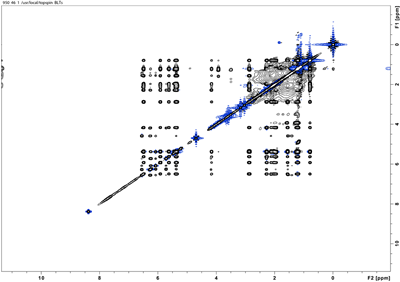Integral membrane protein/amphipol complexes and high-resolution solution-state NMR spectroscopy.
5_ Applications: NMR studies of GPCRs associated to amphipols and of their ligands (1/2).
Application of solution NMR to GPCRs is rare, mainly due to the difficulty of producing sufficient amounts of functional receptors. Amphipol-assisted folding of BLT2 has made it possible to solve by NMR the structure of its natural ligand, LTB4 , in its receptor-bound state. Perdeuterated BLT2 receptor was overexpressed in E. coli as inclusion bodies and folded to its native state (Dahmane et al. (2009)) in deuterated A8–35. The high-resolution structure of the BLT2-bound leukotriene was derived from transferred nuclear Overhauser effect signals (Catoire et al. (2010a)) (Figure 11).
The ligand undergoes a drastic reorganization upon binding, switching from an elongated structure with many coexisting rotamers to a highly constrained conformation (Catoire et al. (2010a)). This information is of great interest from a pharmacological point of view, because it opens new perspectives in BLT-targeted drug design (no antagonists of this LTB4 -mediated pro-inflammatory pathway are available today for clinical use). It also contributes to a detailed analysis of the molecular events that lead to receptor activation. Because the ability of amphipols to fold and stabilize membrane proteins seems quite general, the same strategy can probably be transposed to many other systems.


![FIG12:
Comparative [15N,1H]CRINEPT spectra of wild-type [u-2H,15N]BLT2 (12.8 μM) in complex with DAPol before (in black) and after (in red) addition of LTB4 (30 μM). Figure: image 2 0f 2 thumb](images_NMR_5/FIG4_thumb.png)